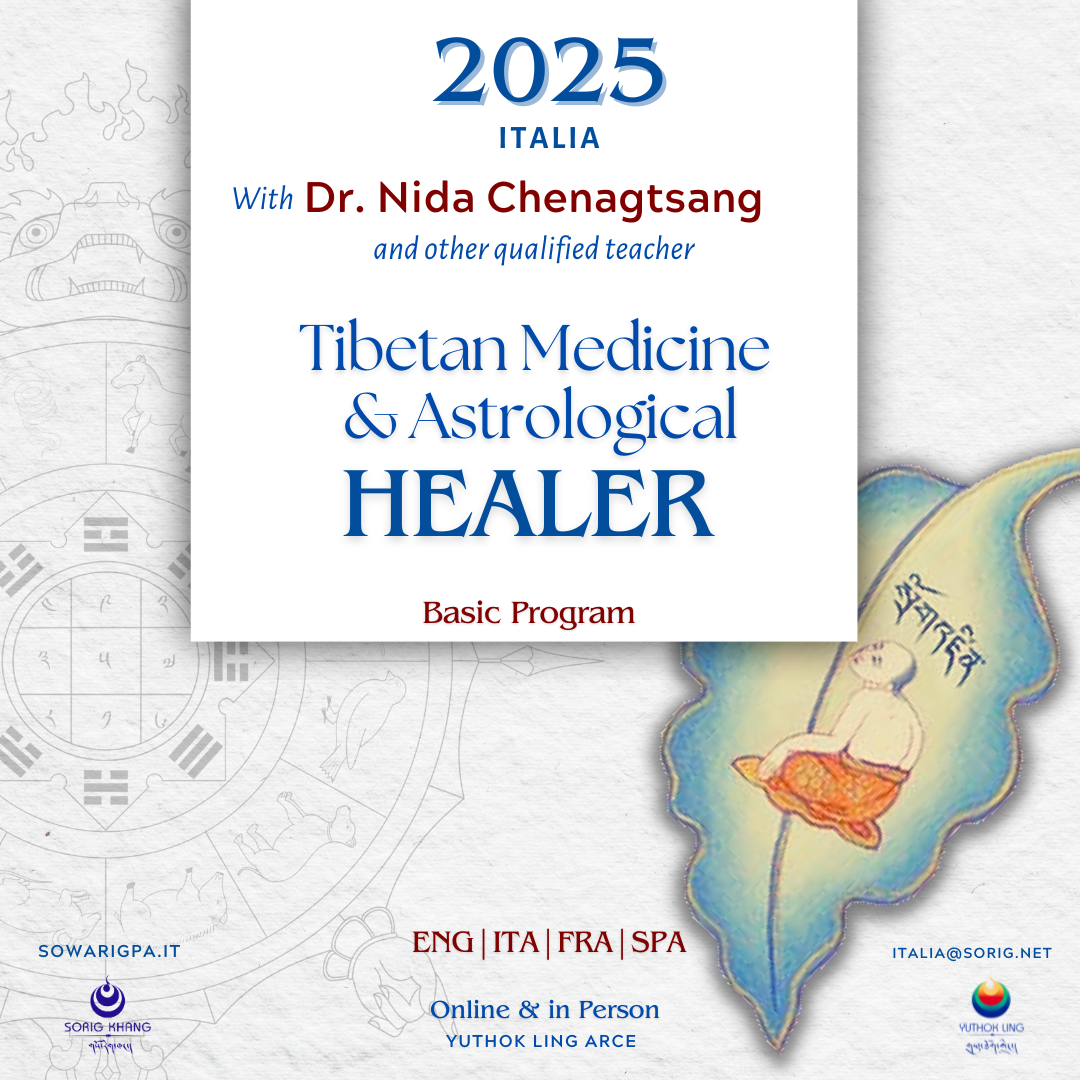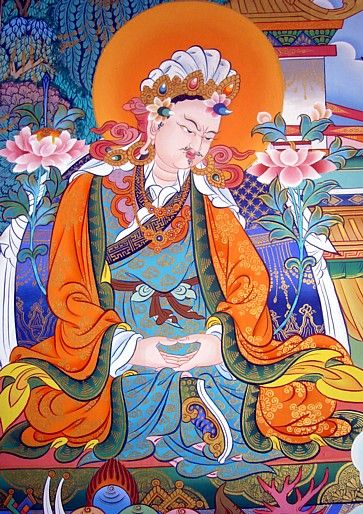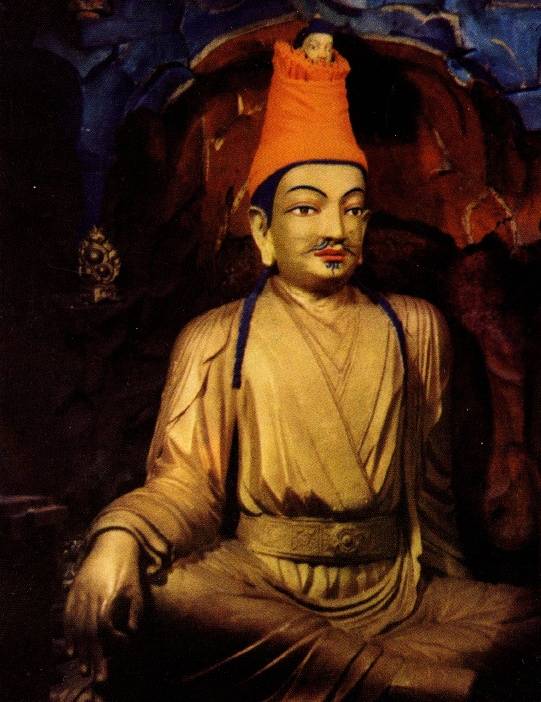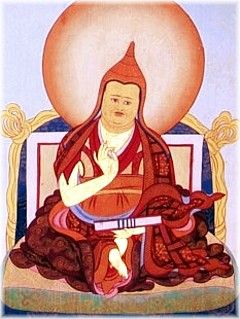UPCOMING COURSES - IN 2025 WITH DR. Nida Chenagtsang
Oct 11
/
Sowarigpa

Since 2006, Dr Nida has been teaching in Italy through the IATTM academy, promoting Sowa Rigpa ( Tibetan Medicine ) throughout Italy and Europe, and beyond. Travelling tirelessly, he contributed to the expansion of the Sowa Rigpa world and the training of thousands of students, and those who went on to become teachers. From 2025, courses will start again in Italy in presence and online in English, Italian, French, and Spanish language.
Registration opens on the first of November, and the course will start in 2025 FROM JANUARY ( we are finalising the calendar ) if you are interested and would like to know more or to be notified when registration opens, please leave us your name by filling in the Form in the appropriate button. If you would like further information please write to italia@sorig.net
UPCOMING COURSES - IN 2025 WITH DR. Nida Chenagtsang
Oct 11
/
Sowarigpa
Finalmente dopo una lunghissima pausa riprendono in italia i corsi di medicina tibetana programma completo (ma Basic) della durata di due anni, con il Dr. Nida Chenagtsang e altri insegnanti qualificati della Accademia - Sorig Khang - Fin dal 2006 il Dr Nida ha insegnato in Italia attraverso quella che era l'accademia IATTM, promuovendo la Sowa Rigpa ( Medicina Tibetana ) in tutto il territorio italiano ed europeo, e non solo. Viaggiando instancabilmente ha contribuito all'espansione del mondo Sowa Rigpa e alla formazione di migliaia di studenti, e quelli che poi sono diventanti insegnanti. Dal 2025 ripartono i corsi in Italia in presenza e online in inglese italiano francese e spagnolo. Le registrazioni aprono il primo di novembre, e il corso partirà nel 2025 DA GENNAIO ( stiamo ultimando il calendario ) se siete interessati e volete sapere di più oppure essere avvisati quando le registrazioni saranno aperte, lasciateci il vostro nominativo compilando il Form dall'apposito pulsante. Se volete altre info scriveteci a italia@sorig.net
UPCOMING COURSES - IN 2025 WITH DR. Nida Chenagtsang
Oct 11
/
Sowarigpa
Dr Nida enseigne et promeut la Sowa Rigpa (médecine tibétaine) à travers l'Italie, l'Europe et au-delà depuis 2006. Voyageant sans relâche, il a contribué à l'expansion de cette tradition médicale et à la formation de milliers d'étudiants dont certains sont à leur tour devenus enseignants. À partir de l'année prochaine, ces cours reprendront en présence en Italie, ils seront disponibles aussi en ligne, en anglais, italien, français et espagnol. Les inscriptions ouvrent le 1er novembre et les cours commenceront en janvier 2025. (nous sommes en train de finaliser le calendrier).Si vous êtes intéressé et que vous souhaitez être informé de l'ouverture des inscriptions, merci de nous laisser votre nom en remplissant le formulaire ci-joint. Pour de plus amples informations, veuillez écrire à italia@sorig.net
UPCOMING COURSES - IN 2025 WITH DR. Nida Chenagtsang
Oct 11
/
Sowarigpa
Desde 2006, el Dr. Nida ha estado enseñando en Italia a través de la academia IATTM, promoviendo Sowa Rigpa ( Medicina Tibetana ) en toda Italia y Europa, y más allá. Viajando incansablemente, contribuyó a la expansión del mundo de la Sowa Rigpa y a la formación de miles de estudiantes, y de aquellos que se convirtieron en profesores. A partir de 2025, los cursos comenzarán de nuevo en Italia de forma presencial y en línea en inglés italiano francés y español. La inscripción se abre el primero de noviembre, y el curso empezará en 2025 A PARTIR DE ENERO ( estamos ultimando el calendario ) si estás interesado y quieres saber más o que te avisemos cuando se abra la inscripción, déjanos tu nombre rellenando el Formulario en el botón correspondiente. Si desea más información escríbanos a italia@sorig.net
Now the website is in two languages
Language switcher with English Flag is below in the botton of the page
Trisong Detsen ཁྲི་སྲོང་ལྡེ་བཙན་

Trisong Detsen ཁྲི་སྲོང་ལྡེ་བཙན་ is the 38th King of Tibet. He ruled Tibet from 755 AD to 797 AD, and he retired after passing the throne to his second son. Trisong Detsen is one of the three Dharma Kings of Tibet, playing a significant role in Introducing Buddhism in Tibet.Trisong Detsen invites Great Indian master Sāntarakṣita and Guru Rinpoche from India to help establish Buddhism in Tibet. Thus subsequently founding the first and oldest sect of Tibetan Buddhism called Nyingmapa Sect with the Samye monastery as the first Buddhist Monastery in Tibet. Guru Rinpoche also help to initiate the first monkhood in Tibet with first seven sons from Noble birth.During the reign of Trisong Detsen, he organizes the first international medical conference of Medicine to introduce the Current Tibetan medicine system. The doctors from all over the known world came to participate including from Greece, China, Arab, India, and Nepal.Trisong Detsen also gathers many spiritual master and translator from India to train many translators to Translate all the Buddhist scripture from Indian to the Tibetan Language.Though facing much opposition from Bönpo follower to resist the change and introduction of Buddhism in Tibet. Besides all the hardship he was successful in establishing Buddhism as the official religion for his royal court and his empire.For Us, Tibetan Buddhist. We consider him as a very great king, and we are always grateful for him to inducing Buddhism in Tibet, which is now the core of Our Tibetan culture and tradition. Therefore during your travel to Tibet, you will find Trisong Detsen statue along with either Guru Rinpoche and śāntarakṣita or along with our other two kings of Songtsen Gampo.
Songtsen Gampo, སྲོང་བཙན་སྒམ་པོ་

Songtsen Gampo is the forefather of Buddhism in Tibet. Two generations before King Trisong Detsen invited Shantarakshita and Padmasambhava to Tibet, King Songtsen Gampo cultivated the nation for its transformation, clearing pathways for the dharma to enter and ultimately permeate Tibetan culture. Without Songsten Gampo there would be no Tibetan alphabet, Lhasa would have no Jokang, and the supreme demoness of Central Tibet might still be roaming the earth unfettered.
Songtsen Gampo reigned from 617 to 650. His Yarlung dynasty was based in Central Tibet during an imperialist period in Tibetan history. Bön was the dominant religion, and Buddhism was only seminally present. No Tibetan translations of the Buddhist scriptures existed, partially because there was no written form of Tibetan, so Songsten Gampo instructed his minister Thonmi Sambota to travel to India, study Sanskrit, and develop a Tibetan script. He then commissioned the translation of several thousand texts.
His celebrated successes in battle expanded the Tibetan empire deep into Nepal and China, and it was during these battles that he gained an appreciation of the neighbouring cultures. As a reminder of the great empire that Songtsen Gampo ruled, a large pillar still stands before the Potala palace in Lhasa, erected during his reign, on which is inscribed the agreement between the Tibetan and Chinese rulers to respect each other’s borders. He studied Chinese, became skilled in the art of leadership, and most importantly, he adopted sacred codes of conduct from Buddhist scripture. Under his rule, sacred practices began to replace the shamanistic practices of the Bönpos.
Songtsen Gampo’s two queens can be credited for a great part of his cultural awareness. Bhirkuti, from Kathmandu, brought the traditions of Himalayan Buddhism. Princess Wengchin, daughter of the Tang emperor, brought a treasure trove of ancient Chinese wisdom. She travelled across the steppes to her husband with a collection of Chinese classic literature and texts on sacred astrology, geomancy, and medicine.
Many obstacles lay in Princess Wengchin’s path as she headed to Yarlung. She had a vision of a gargantuan demoness who lay sprawled across the Himalayas, so large that one limb lay in Paro, Bhutan and another lay in Western Tibet. When she arrived in Yarlung, she shared her vision with her new husband. Recognizing the value of the treasures that his bride brought to him, as well as the importance of her vision, King Songsten Gampo commissioned thirteen demoness-subjugating temples across the land, built over the demoness’s vital organs, ankles, wrists, and torso, forever binding her from wreaking havoc. The Lhasa Jokang was built over her heart centre, and Wengchin’s Buddha statue was placed inside, where it still resides. Other such temples are Trenduk Lhakhang in Tsetang and Paro Kyichu in Bhutan.
King Songtsen Gampo is considered a human emanation of Avalokiteshvara, and he was the grandfather of King Trisong Detsen. Songtsen Gampo meditated for several years in a cave that is now at the core of Potala palace, and is revered for his great patronage of Buddhism.
Through his enlightened leadership, the path was cleared for the dharma to be propagated throughout the provinces, and for Buddhism to flourish.
Ju Mipham Rinpoche ( འཇུ་མི་ཕམ་,

Ju Mipham Rinpoche (Tib. འཇུ་མི་ཕམ་, Wyl. 'ju mi pham) or Jamgön Mipham Gyatso (Tib. འཇམ་མགོན་མི་ཕམ་རྒྱ་མཚོ་, Wyl. 'jam mgon mi pham rgya mtsho) (1846-1912) — a great Nyingma master and writer of the last century, student of Jamgön Kongtrul, Jamyang Khyentsé Wangpo and Patrul Rinpoche. Blessed by Manjushri, he became one of the greatest scholars of his time. His collected works fill more than thirty volumes. His chief disciple was Shechen Gyaltsab Pema Namgyal.
Terma (གཏེར་མ་, Wyl. gter ma)

Terma (Tibetan: གཏེར་མ་, Wylie: gter ma; "hidden treasure") are various forms of hidden teachings that are key to Vajrayana or Tibetan Buddhist and Bon religious traditions. The belief is that these teachings were originally esoterically hidden by various adepts such as Padmasambhava and dakini such as Yeshe Tsogyal (consorts) during the 8th century, for future discovery at auspicious times by other adepts, who are known as tertöns. As such, terma represent a tradition of continuous revelation in Vajrayana or Tibetan Buddhism. Termas are a part of tantric literature.
1. Terma Tradition
1. Terma Tradition
Tradition holds that terma may be a physical object such as a text or ritual implement that is buried in the ground (or earth), hidden in a rock or crystal, secreted in a herb, or a tree, hidden in a lake (or water), or hidden in the sky (space). Though a literal understanding of terma is "hidden treasure", and sometimes refers to objects that are hidden away, the teachings associated should be understood as being 'concealed within the mind of the guru', that is, the true place of concealment is in the tertön's nature or essence of mind. If the concealed or encoded teaching or object is a text, it is often written in dakini script, a non-human type of code or writing that only a tertön can decipher.
In this way, one may see the tradition of terma and tertön as analogous to that of inspiration and providing a legitimate cultural forum to ensure continuation of tantric tradition, and ensuring Tibetan Buddhism's and Bön's continued relevancy in an evolving world.
In this way, one may see the tradition of terma and tertön as analogous to that of inspiration and providing a legitimate cultural forum to ensure continuation of tantric tradition, and ensuring Tibetan Buddhism's and Bön's continued relevancy in an evolving world.
The terma tradition is particularly prevalent in, and significant to, the Nyingma lineage. Two of the most famous tertön in the 20th century, Jigdral Yeshe Dorje (2nd Dudjom Rinpoche) and Dilgo Khyentse, were Nyingmapa. Tertön are also prevalent in Bön traditions and a few tertön have been Kagyupa.
Padmasambhava and his principal consorts and disciples secreted away and hid religious texts, ritual objects and relics etc., to secure and protect Buddhism during the time of decline under Langdarma. Some of these terma have been rediscovered and special terma lineages established throughout Tibet as a result. Out of this activity developed, especially within the Nyingma tradition, two ways of dharma transmission: the so-called "long oral transmission" from teacher to student in unbroken disciplic lineages, and the "short transmission" of terma. The foremost revealers of these terma were the Five Terton Kings and the Eight Lingpas. In the 19th century, some of the most famous were the Khenkong Choksum referring to Jamyang Khyentse Wangpo, Jamgon Kongtrul and Orgyen Chokgyur Lingpa.
Terma have been relayed by nāga and the dakini - of the underworld and the heavens, respectively - and have also been hidden by teachers such as the great translator Longchenpa. Sometimes terma are discovered by a master and reconcealed for a later tertön to find. (Encyclopedia: From Scholars for Scholars)

